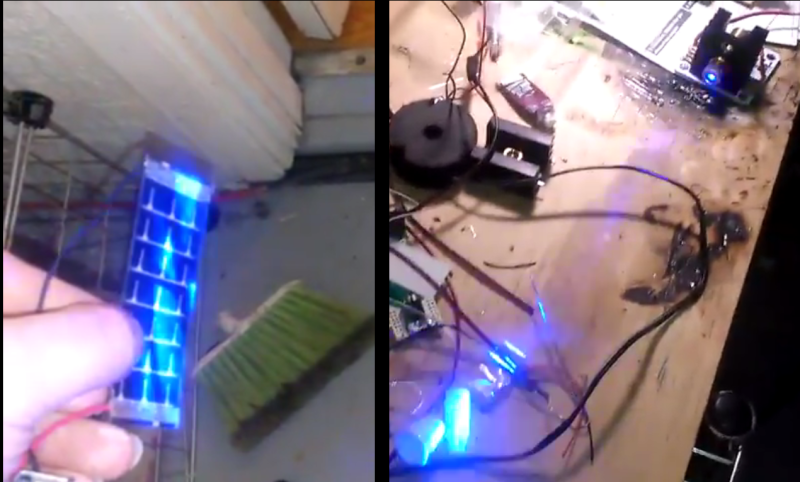With its vintage sound, there’s no mistaking the unique 8-bit sound of video games from the 80s and 90s. It became so popular that eventually sparked its own genre of music known as “chiptune” for which musicians are still composing today. The music has some other qualities though, namely that it’s relatively simple from a digital standpoint. [Robots Everywhere] found that this simplicity made it perfect as a carrier for wireless power transmission.
The project acts more like a radio transmitter and receiver than it does a true wireless power transmitter, but the principle is the same. It uses a modified speaker driver and amplifier connected to a light source, rather than to a speaker. On the receiving end, there is a solar panel (essentially a large photodetector) which is wired directly to a pair of earbuds. When the chiptune is played through the amplifier, it is sent via light to the solar panel where it can be listened to in the earbuds.
The project is limited to 24,000 bytes per second which is a whole lot more useful than just beaming random audio files around your neighborhood, although that will still work. You can also use something like this to establish a long-distance serial link wirelessly, which can be the basis of a long distance communications network.
Thanks to [spiritplumber] for the tip!

















Good project that I did as a kid. Instead of a chiptunes as a source it was a cassette player with the headphone spliced into a flashlight.
The headphone driver was strong enough to drive an incandescent bulb? Didn’t get any problems with transmitting that high a baud rate with the amount of time an incandescent filament takes to warm up and cool off?
I think he is referencing (probably) a Forrest Mims project from an old radio shack circuit book. It used a little flashlight bulb to send spoken sound to a CdS receiver connected to a lil mono piezo headphone. The main difference being an analog wave vs this one’s data transmission. I still have the book somewhere. If I can find it I could be more specific. My memory is starting to fail so I apologize if I got it completely wrong. I just remember building what he is talking about. Someone else will probably post a more exact thing before this comment gets approved anyway…
lol
I can’t speak to the data rate, But…
The headphone output of most portable cassette decks, was a simply a resistor in series between the main speaker driver circuit and the headphone jack.
Bypass the resistor and enjoy the ability to plug in a slightly better speaker. X^D
If memory serves, the audio was as likely as not, to be a class “A” (single transistor in the last stage) circuit.
My understanding of this was for keeping parts count and manufacturing cost lower.
Maybe someone with some actual time as a designer could correct my thoughts?
Interesting work stories would be a bonus!
Audio doesn’t have a “baud rate”. And the slow response of a bulb – that’s just a low-pass filter. Nobody is talking high fidelity reproduction here. If the audio is recognisable, that’s a success.
Same here…i was just playing around with a solar panel, and thought, “If I hook this headphone jack to bulb…” I was even more impressed when I put a solar panel to a television tuned to a static-y portion of the spectrum. The panel decoded the audio from the snow. That was a fun discovery :)
Thinking about it more, perhaps it was the speaker output, not the headphone jack.
Where does the number 24000bytes/s (192kbits) come from?
The Nyquist limit on 48kHz audio? (Just guessing)
Probably, but then that isn’t the actual baud rate limit of the transmitter. Unless an outrageous coincidence is happening.
Nor is it the limit of the receiver or of the sensor (solar cell). I’m sure it is also limited by the frequency of light, which could also be given as “the limit of the project”.
Thanks to both of you for the hint with the 48kHz audio. Doesn’t sound like 48kHz audio.
quote:
‘became so popular that eventually sparked its own genre of music known as “chiptune”’
Then there was CHIPCORE, CHIPTEK and even CHIPSTEP.
CHIPSTEP!!!! Who woulda thunk’d it???
(p.s. comment parts are intentionally spelt for phonetics instead of correctness)
I’ve tried to understand goattracker2, sid-wizard, and defmon for past few days but writing your own synthesis tables and such gives me terrible headache. Altough , c64 sid chips are so hard to come by these, I was fortunate enough to get an old atari from a friend, hoping to take out that POKEY soon.
If you want to adapt it for in-situ chiptune generation, you can tac on an Arduino with Duinotune https://github.com/blakelivingston/DuinoTune :)
If you want to try integrating in-situ chiptune generation you could try a build of DuinoTune https://github.com/blakelivingston/DuinoTune – Converts chiptune modules from renoise into buildable code with roughly NES level synthesis – plays out of a PWM pin, so no DAC needed. (full disclosure – author plug)